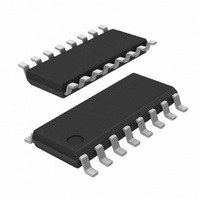SI3015-F-FS Silicon Laboratories Inc, SI3015-F-FS Datasheet - Page 82

SI3015-F-FS
Manufacturer Part Number
SI3015-F-FS
Description
IC ISOMODEM LINE-SIDE 16SOIC
Manufacturer
Silicon Laboratories Inc
Type
Chipsetr
Specifications of SI3015-F-FS
Package / Case
16-SOIC (3.9mm Width)
Data Format
V.90
Interface
Serial
Voltage - Supply
3.3 V ~ 5 V
Mounting Type
Surface Mount
Product
Modem Chip
Supply Voltage (min)
3 V
Supply Current
26 mA
Maximum Operating Temperature
+ 70 C
Minimum Operating Temperature
0 C
Mounting Style
SMD/SMT
Lead Free Status / RoHS Status
Lead free / RoHS Compliant
Baud Rates
-
Lead Free Status / Rohs Status
Compliant
Available stocks
Company
Part Number
Manufacturer
Quantity
Price
Company:
Part Number:
SI3015-F-FSR
Manufacturer:
SAMSUNG
Quantity:
2 000
Part Number:
SI3015-F-FSR
Manufacturer:
SILICON LABS/芯科
Quantity:
20 000
Si2400
The billing tone filter affects the ac termination and
return loss. The current complex ac termination will
pass worldwide return loss specifications both with and
without the billing tone filter by at least 3 dB. The ac
termination is optimized for frequency response and
hybrid cancellation, while having greater than 4 dB of
margin with or without the dongle for South Africa,
Australia, CTR21, German, and Swiss country-specific
specifications.
In-Circuit Testing
The Si2400’s advanced design provides the system
manufacturer with increased ability to determine system
functionality during production line test, as well as
support for end-user diagnostics.
The CLKOUT pin of the Si2400 can be used as an initial
indication that the Si2400 is functional. Upon power up
and the negation of the reset pin, the CLKOUT pin
oscillates at 9.8304 MHz, which is twice the input clock
frequency of 4.9152 MHz. Testing the frequency of
CLKOUT indicates that the Si2400 internal clock is
operational. To test communication with the Si2400
across the UART, the local echo may be used
immediately after the part has been properly reset.
There are many methods to check to discover whether
the ISOCAP link between the Si2400 and Si3015 is
operational. These tests do not require any loop current
on the DAA. The first method is to check SF2[3] (FDT).
If it is set, the Si2400 and the Si3015 are
communicating. Another method is to read SF8[7:4]
(LRV) to verify the Si3015 is properly sending its version
number back to the Si2400. Finally, the voltage between
the Si3015 VREG pin and the IGND pin may be
measured and must exceed 3.6 V.
Once the clock, UART, and isolation link have been
proven to function, the production test can proceed to
verify operation of the discrete components mounted on
the board. In general, there are two approaches to
production line test. The first approach is to execute
complete modem connections through a commercially
available telephone line simulator. This approach is
simple to implement but incurs a relatively long per unit
test time. If per unit test time is an important
consideration, another approach is to use the internal
tone generator on the Si2400 to generate a tone at TIP/
RING. The Si3015 can be programmed to disable the
hybrid (clearing SF1[2] [HBE]), thereby allowing the
transmitted signal to be looped back through the receive
path.
82
Rev. 1.3
The Si2400 receives the loopback tone and should be
programmed to drive the tone to AOUT. This approach
requires loop current consistent with the equivalent
circuit shown in Figure 1.
As an example, the following strings can be sent to the
Si2400 to set up the 2225 Hz answer tone as the
stimulus waveform.
1. ATE0SF1=18SF7=00SF0=01 to go off hook and to disable
2. ATSE4=02M2SF4=03 to drive AOUT with the received
3. ATSE8=00SE6=00SE5=0BSE8=01SE6=08SE5=FCSE8=0
4. ATSE8=02SE5=04SE6=02 to begin the 2225 Hz answer
With the above strings a number of points can be
probed to determine if the DAA is functioning properly.
Assuming a 30 mA loop current, the dc value of the TIP/
RING voltage should be in the neighborhood of 7.5 V.
The actual voltage is dependent on the chosen dc
Termination. Refer to Figures 14, 15, and 16.
The amplitude of the 2225 Hz tone on AOUT should be
around
amplitude consistent with a –12.9 dBm signal. The
digital filters introduce the 0.9 dBm attenuation. The
transmitted tone is set to a –12 dBm level so that when
the hybrid is disabled, an internal dc offset is realized.
The size of this dc offset is approximately half scale. To
guarantee no clipping under all conditions, a –12 dBm
maximum is recommended. If a slightly distorted signal
is acceptable on AOUT, a signal exceeding –12 dBm
may be implemented instead using the method shown
in step 3 above.
In order to complete the production test, it may be
necessary to simulate a ring signal. A sine wave pulse
of 500 ms with a 20 Hz frequency and an amplitude of
35 V
result code. Additional production tests may be
employed to check the DAA. For example, a 300 V dc
test between TIP and RING can be used to ensure that
the hookswitch transistors are operational and are not
leaking any significant amount of current. Also, a HIPOT
(High
longitudinally between TIP/RING and GND can be used
to ensure that the isolation barrier is not bridged
inadvertently.
transmit hybrid.
loopback tone from the line.
0 to set the tone amplitude to –12 dBm.
tone.
RMS
Potential
500 mV
is sufficient for the Si2400 to return an “R”
such
peak-to-peak,
as
1500 V)
corresponding
test
applied
to














